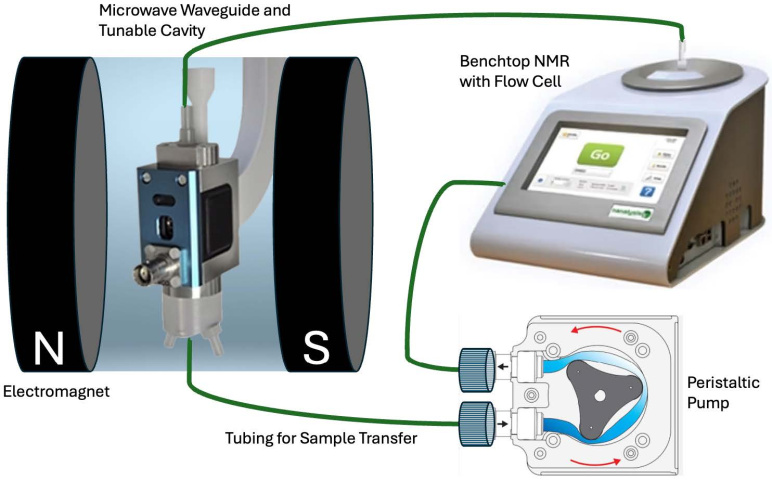Our Research Bench-top NMR with dynamic nuclear polarization for ultra-sensitive PFAS detection

A diagram showing an integrated system wherein PFAS is hyperpolarized in a microwave cavity and then transferred by a pump to a benchtop spectroscopic method called Nuclear Magnetic Resonance (NMR) for collection of a spectrum.
Principal Investigators
Challenge:
How can we develop a simplified method to detect and identify PFAS in water using NMR? Success will offer a lower-cost alternative to current EPA methods based on mass spectrometry.
Research Strategy
- Develop PFAS absorptive materials that can be excited with microwaves to align the magnetic state of the fluorine atoms in the molecules
- Optimize materials for the magnetization of the fluorines by changing he concentration of electron spins in the materials
- Demonstration of methods that allow for the release and transfer of magnetically aligned PFAS to an NMR spectrometer via tubing
- Final integration of a polarizer and a bench-top NMR and determination of the limits of detection for PFAS at the EPA limits for drinking water
Project description
Per- and poly-fluoroalkane substances (PFAS) are materials with broad utility as a result of their high stability and oleophobic character. However, PFAS chemicals are not biodegradable and do not burn. The result is that PFAS has accumulated in the environment and in our bodies over time. Exposure to PFAS has been associated with adverse health effects, including altered immune function, liver disease, kidney disease, and cancer. Due to their harmful effects, the EPA has issued new impending regulations on the acceptable concentrations of PFAS in drinking water. Current EPA methods require expensive (>$500k) liquid chromatography tandem mass spectrometry (LC/MS/MS) equipment, highly skilled operators, and they struggle in determining highly complex mixtures containing PFAS species beyond the six PFAS targeted for regulation.
Fluorine-19 Nuclear Magnetic Resonance (NMR) is a spectroscopic method that provides a more accurate, easy-to-use alternative. Using dynamic nuclear polarization wherein the 100% magnetically abundant Fluorine-19 nuclei are aligned with an applied magnetic field, the team will develop NMR methods that meet the EPA parts per trillion PFAS detection limits, that can be operated by unskilled users, with equipment capital costs that are <20% of the current methods that use liquid chromatography-tandem mass spectrometry (LC/MS/MS).
News
Additional Details
Impact Areas
- Water
Research Themes
- Sensors & Monitoring
Year Funded
- 2025
Grant Type
- Seed Grant
Status
- Ongoing



